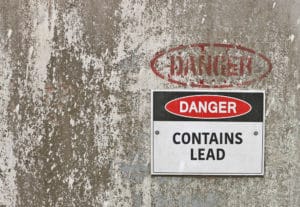
An investigation from Radio Canada has found that Canadian shipyard workers and members of the Canadian Coast Guard were not provided personal protective equipment (PPE) when tasked with working on vessels contaminated with lead paint. According to the investigation, their employers had “strong reasons” to believe that lead paint was present. However, they failed to provide PPE for months, leaving workers at risk for a toxic maritime injury.
Canadian Shipyard Workers at Risk for Lead Paint Exposure
According to a report from CBC News, the Canadian Coast Guard acquired three ships as part of a $610 million icebreaker procurement. The ships – the Jean Goodwill, Vincent Massey and Captain Molly Kool – were acquired through Chantier Davie Canada Inc. The ships arrived in the Davie shipyard in summer 2018 to undergo repairs and modifications.
One ship’s overhaul was complete in December 2018, but the other two are still in dry-dock being repaired. In February 2020, work on the two remaining ships was halted after the Coast Guard conducted a risk assessment. Consequently, both ships tested positive for lead paint.
Davie and the Coast Guard knew that the completed ship tested positive for lead, because it was examined in August 2019 after it went into service. The conclusive results of those tests came back in October 2019. Still, shipyard workers were not warned of the risk and were not provided PPE.
In a statement sent to Radio Canada, the Coast Guard says,
“The results of the risk assessment were communicated the same day to Chantier Davie Canada Inc.”
If so, the employer never communicated the risk of lead exposure to workers, and did not provide them with PPE. Measures to safeguard shipyard workers from lead exposure were not implemented until February 2020 – after the work was halted.
In short, shipyard workers were unwittingly exposed to toxic lead particles for over a year.
What is Lead Paint?
Lead-based paint, or lead paint, was commonly used in residential and commercial industries prior to the 1970’s. Lead is an ingredient in paint that serves as a pigment, particularly for red, white and orange paints. It is also an additive to help accelerate drying time and increase durability.
Lead paint was often used in the maritime industry because of its durability and the fact that it resists moisture. These are important features for ships that will sit in water and will be subject to changing weather conditions.
In 1978, the U.S. federal government banned lead paint in residential and public properties, and in the manufacturing of many consumer goods. Since then, the use of lead paint has declined dramatically. Unfortunately, the damage was already done.
Today, homes, products and ships still contain lead paint, which puts those working around them at risk for exposure to lead. When workers peel, blast or sand away lead paint, the particles become hazardous, such as the shipyard workers we discuss above.
What are the Risks of Lead Exposure?
Healthcare experts say that there is no safe level of lead exposure. Maritime workers may breathe in lead particles or even swallow them. They can also be absorbed through the skin. When lead enters the body, our blood, bones and tissue absorbs and stores it. According to the Centers for Disease Control and Prevention (CDC), lead stays in the body as a source of continual internal exposure.
Over time, and especially as we age, the body releases lead from bone tissue. There is a great deal of concern that older individuals may experience larger amounts of lead mobilizing from bone.
Lead exposure is dangerous in high levels of lead over a short period of time, or low or moderate levels for a longer period of time. Depending on your exposure, you may experience:
Short-Term Lead Exposure:
- Abdominal pain
- Headache
- Fatigue
- Constipation
- Irritability
- Loss of appetite
- Memory loss
- Weakness
- Pain or tingling in the feet and hands
Lead poisoning from short-term exposure can be difficult to pinpoint. These symptoms are consistent with a variety of medical conditions. It is important that you tell your healthcare provider if you work around lead paint, or you have concerns about possible exposure to lead.
If you are exposed to a high level of lead, you may also experience lead poisoning. Lead poisoning can cause anemia, brain damage and kidney problems. Severe lead poisoning can also cause death.
Prolonged Lead Exposure:
- Abdominal pain
- Nausea
- Constipation
- Depression
- Distracted
- Forgetful
- Irritability
If you have been exposed to lead for a prolonged period of time, you are at risk for complications including high blood pressure, heart disease and kidney disease.
The Environmental Protection Agency (EPA), the Department of Health and Human Services (DHHS) and the International Agency for Research on Cancer (IARC) also believe that lead may cause cancer in humans.
Lead Exposure in Women and Children
The CDC considers women and children as most vulnerable to the harmful effects of lead exposure. In women, lead exposure can cause infertility, miscarriage and stillbirth. Lead can also pass the placental barrier, meaning that developing fetuses are also at risk of lead exposure. Lead exposure during pregnancy can affect development of the fetal nervous system. Infants may also experience difficulties with behavior and intelligence.
Children exposed to lead often experience more severe toxicity than adults. Lead poisoning can occur due to exposure to lead paint, consumer products or dust brought home by their parents. Children who have lead poisoning may experience neurological and intellectual disabilities.
What Shipyard Workers Can Do to Avoid Lead Exposure
While lead paint is still present in many areas of the maritime industry, there are things that employers and workers can do to prevent lead exposure.

The CDC recommends the following measures:
- Survey all work sites for lead-containing items.
- Monitor exposure as required by the Occupational Safety and Health Administration (OSHA).
- Replace lead-containing products with lead-free or lower lead content products.
- If replacing products is not possible, ensure that workers have proper training and equipment to prevent exposure.
- Ensure that workers have appropriate PPE, including goggles, respirators, coveralls and gloves.
- Have workers who work around lead routinely tested with a Blood Lead Level test.
- Provide workers with a lead monitoring program. Include biological and medical monitoring and surveillance. Such a program is required by OSHA if workers are exposed to lead above the “lead action level.”
- Ensure that workers have adequate and effective lead removal products. The National Institute for Occupational Safety and Health (NIOSH) has developed specific lead removal products.
- Provide access to NIOSH hand wipes, which can instantly tell workers if lead is present on their hands.
- Employers who have concerns about lead exposure can contact NIOSH to request a free environmental assessment.
- Employers can also utilize OSHA’s Consultation Program, which provides free services to workplaces that may contain hazards.
- All employers and shipyard workers should be aware of OSHA Lead Standards. Furthermore, employers and workers should contact OSHA to learn more about specific standards and state requirements.
Have Questions about Toxic Exposure in the Maritime Industry?
The maritime industry consistently ranks as one of the most hazardous. There are a variety of potential toxins and chemicals that maritime workers may come in contact with. Above, we discuss the potential for shipyard workers to suffer exposure to lead. In addition to lead, maritime workers may be at risk of exposure to:
- Hydrogen Sulfide
- Asbestos
- Silica Dust
- Benzene
Exposure to any of these toxins can certainly cause medical problems. Employers have a legal responsibility to limit the potential for exposure by assessing work environments and equipping workers with PPE. Sadly, employers do not always fulfill this obligation.
If you are a maritime worker who is suffering the adverse effects of toxic chemical exposure, contact Maritime Injury Guide. Let our maritime lawyer help you explore your legal rights and possible options for benefits or compensation.
Call us at 866-871-8422 to request a free injury consultation. Or, you can also email us using our online contact form.
Sources: